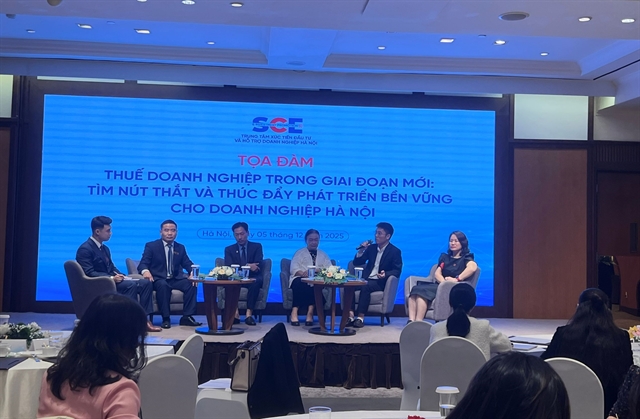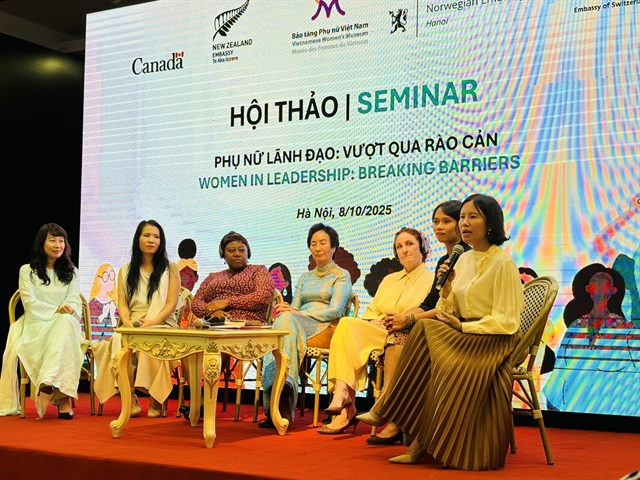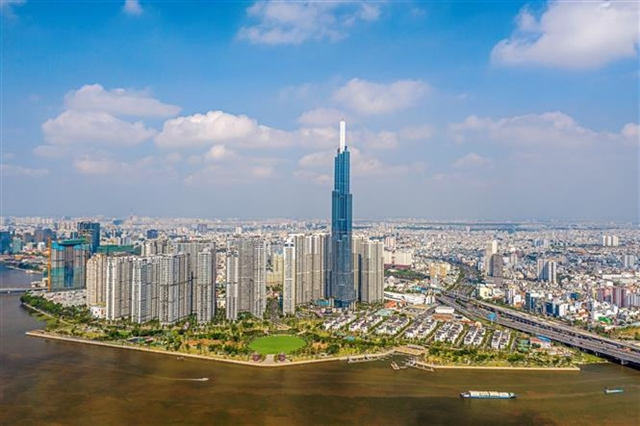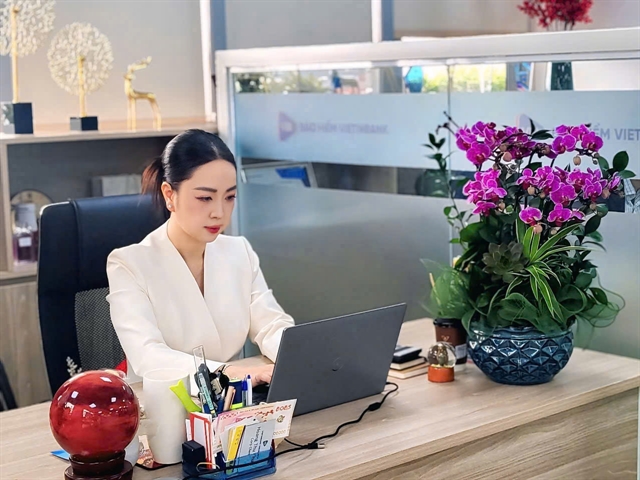 Society
Society

 |
| Female speakers tell inspiring stories about their leadership journeys to overcome barriers. VNS Photo Khánh Dương |
Khánh Dương
HÀ NỘI — Việt Nam is witnessing gradual progress in women’s leadership, yet societal and self-imposed perceptions continue to limit their advancement, experts said at a seminar in Hà Nội this week.
To mark Vietnamese Women’s Day on October 20, the embassies of Canada, New Zealand, Norway and Switzerland, in collaboration with the Việt Nam Women’s Museum, co-hosted the seminar 'Women in Leadership: Breaking Barriers.'
The event featured inspiring stories from both Vietnamese and foreign female leaders who shared their journeys of overcoming obstacles, leading with purpose and empowering other women, encouraging participants to recognise their potential, challenge social norms and pursue their aspirations.
Nguyễn Thị Thanh Hòa, chairwoman of the Association for the Protection of Children’s Rights and former president of the Việt Nam Women’s Union, said Việt Nam’s Gender Equality Index in 2024 rose by 11 places, from 83rd to 72nd out of 146 countries.
However, she noted, the proportion of women in leadership positions is still not commensurate with their important role in society.
“Most women-owned businesses are small or micro-sized and female entrepreneurs remain underrepresented in key positions within major corporations,” she said.
Female leaders continue to face numerous challenges and barriers.
“Society’s perception of women’s roles remains limited, while there is insufficient understanding and support from families. Particularly, the barriers that come from within women themselves are also significant.”
Hòa, a former member of the Party Central Committee and National Assembly deputy, said: “Many people still believe that if a woman fulfils her family responsibilities well, that is already enough. In fact, when assessing women, society often values those who fit traditional family roles more than those who have achieved higher professional positions.”
“It is important to change social perceptions and awareness of women’s roles, while also helping women themselves better understand and fully realise their own rights, responsibilities and self-worth.”
Associate Professor Nguyễn Thị Lan Anh, vice president of the Diplomatic Academy of Việt Nam, said: “When female diplomats step into a meeting room, people sometimes look at us as though we are merely ‘moving flower vases,’ questioning whether we can truly contribute. Such perceptions are still quite common, especially in male-dominated fields like politics, law or maritime and ocean security.
“When I entered this profession some 30 years ago, many female department directors said their greatest wish was to become the first female ambassador because, at that time, the position was almost exclusively reserved for men.
"But now, we can proudly say that at the departmental level in the Ministry of Foreign Affairs, women make up the majority. In fact, among Vietnamese ambassadors in Europe today, women also hold the majority. This shows a remarkable shift in awareness, both within the diplomatic sector and in politics more broadly.
“I have never thought of being a woman as an inferiority or a disadvantage, nor do I see women as being in a weaker position. I believe that being able to ‘manage state affairs and family matters’ is not a burden placed on women, but rather an opportunity — an advantage that, in some ways, allows us to excel even more than men.”
.jpg) |
| Prime Minister Phạm Minh Chính met with Vietnamese and international female diplomats in July to celebrate International Day of Women in Diplomacy of the UN. VNA/VNS Photo |
New Zealand Ambassador to Việt Nam Caroline Beresford said perceptions remain one of the biggest barriers for women in leadership.
“I’m not just talking about the perception of others — about what a leader looks like, sounds like or acts like — but also our own perceptions of what we feel about our own leadership,” she said.
She highlighted the common issue of imposter syndrome among professional women, where they feel like frauds despite their accomplishments.
Recalling her own experience, she said: “When I entered my first leadership role about a decade ago, it was a very frightening prospect. For the first time in my career, I felt the resentment of my male colleagues about me assuming that position. They were very comfortable with me in the workplace. Until then, I hadn't experienced any barriers or sexism, but as soon as I got to a level where I was assuming positions that were traditionally male, I found the attitude change.”
She stressed the importance of courage and confidence for women in leadership positions and the need for young women to hear about these challenges.
“By talking about our experiences, we can make workplaces more friendly and supportive for future generations,” she said.
Norwegian Ambassador to Việt Nam Hilde Solbakken said cultural norms, institutional biases and unequal access to opportunities continue to hold women back in Việt Nam, in Norway and around the world.
“If we neglect the need to empower women and girls, we pay for that by weakening our country’s performance. No country can afford to utilise only half of its human capital,” she said.
Sharing experience from Norway, she said: “In Norway, women hold senior positions across all sectors. Nearly 45 per cent of our members of Parliament are women, and for decades, our government has had almost equal numbers of men and women ministers. Norway was the first country to appoint a gender equality ombud and we have consolidated our equality legislation into one dedicated Gender Equality Act.”
Since 2005, Norway has mandated gender-balanced corporate boards, first in public limited companies requiring at least 40 per cent of each gender. As of January last year, these rules were expanded to private companies above a certain size.
“Thousands of companies are now adapting to ensure compliance — and in that process, they are fostering diversity and inclusion in leadership,” she said.
Breaking stereotypes
Not working in the political sector but in biodiversity conservation, Trang Nguyễn, founder and director of WildAct Việt Nam, has witnessed gender inequality in her field and strives to encourage women and girls to take on leadership roles in conservation.
She shared a story about one of her female students who joined a conservation training course.
“At midnight, she called me and said it was her first time going on a field trip — actually going into the forest for work. But to be honest, it was quite unsettling: she faced sexual harassment,” Trang said.
When the girl reported the incident to her line manager, she was told: “Well, that’s what happens when girls go into the forest — you have to accept it.”
“If that’s the kind of response we continue to get, how can any young woman stay motivated to keep working in the conservation field?” Trang asked.
“At that moment, I realised that even though all of us here are deeply committed to conservation in Việt Nam, if we don’t build a safe, healthy and equal working environment, young people, especially young women, will eventually leave.”
A recent survey on sexual harassment in Việt Nam’s conservation sector, involving 114 men and women, both Vietnamese and foreign, found that five out of six respondents had experienced sexual harassment at work. Yet when such cases were reported, the response was often dismissive — such as being told: “You went into the forest alone, what did you expect?” or “If you make a fuss, it will affect your organisation’s reputation.”
WildAct is the only local non-governmental organisation in Việt Nam that offers a dedicated programme on gender equality despite working in the conservation field. The programme includes training on what constitutes gender-based violence and sexual harassment and how to recognise and support those affected.
Trang said many of her partners from other organisations, especially men, still prefer to speak only to WildAct’s male staff, assuming that women do not understand technology or science.
“We need to ensure that women have equal access to knowledge and training in technology and science — that’s how we can truly empower them and promote more women into leadership roles, giving them the same opportunities as men,” she said.
“Just like in conservation, where a healthy forest depends on the diversity of all its species, a society can only thrive, grow stronger and become more sustainable when it embraces diversity — men and women, people of different gender identities, the young and the old, and all segments of the community.” — VNS




.jpg)